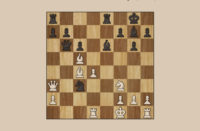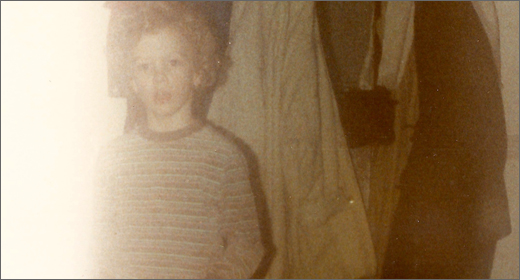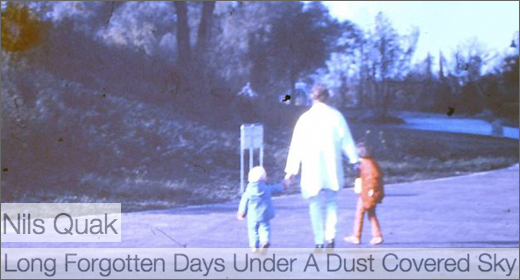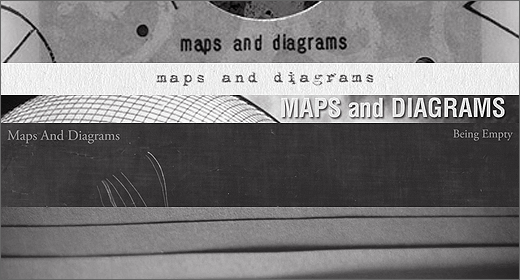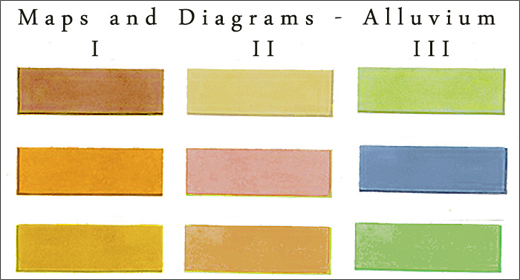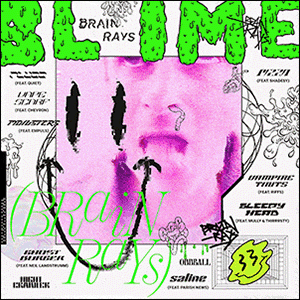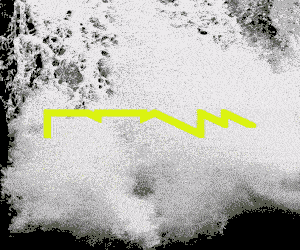‘My personal journey through music started over 12 years ago, I have travelled a lot musically myself over that time in my own work and with various collaborative projects allowing me to alter the way I see and hear music from others’ perspective.’ (Tim Martin, Maps & Diagrams)
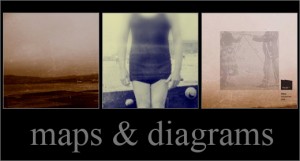 A voyage around Tim Martin via Maps and Diagrams, an audio-tour of taking in historical ports of call, prefaces reviews of current Tim-released sound. Over the last decade Martin’s been engaged in revision of M&D, departing from a refined kind of IDM on labels like Expanding, Cactus Island, Static Caravan, and Moamoo, the likes of “Lost Mechanics” (Polytuft-Tech, 2003), “Stmble” (Caoutchouc, 2004), “Fiord” (Perspect, 2005), “Just Beyond Traskmassen” (Antennas And Signals, 2006), and “Walnut Creek” (Smeg, 2008). Admittedly all that post-AE Arovane-esque skitter-scatter beats + synth-wibble jazz now strikes as a tad quaint—more igloomag.com ’02 than ’12, but the sound-artistry is evident. The shape of things to come was heralded on nifty Smallfish 3”, Lhasa Apso (“Oulujärvi”). And in just a couple of years, with a sideways shimmy, M&D then evolved into one of the best exponents in electro-acoustic ambient-drone. The gorgeous pair of Foel and Koom were first sites of the new more ambient soundscape-y strain, with “Utgores” and “Gelaur”, and other lowlight gems. A prolific 2010/11 brought a raft of floaty-drifty crinkle-cut goodies: Get Lost on Time Released Sound, The Voices of Time on Handstitched, and Red Moon Rising on Chemical Tapes, to name but three. More to follow…
A voyage around Tim Martin via Maps and Diagrams, an audio-tour of taking in historical ports of call, prefaces reviews of current Tim-released sound. Over the last decade Martin’s been engaged in revision of M&D, departing from a refined kind of IDM on labels like Expanding, Cactus Island, Static Caravan, and Moamoo, the likes of “Lost Mechanics” (Polytuft-Tech, 2003), “Stmble” (Caoutchouc, 2004), “Fiord” (Perspect, 2005), “Just Beyond Traskmassen” (Antennas And Signals, 2006), and “Walnut Creek” (Smeg, 2008). Admittedly all that post-AE Arovane-esque skitter-scatter beats + synth-wibble jazz now strikes as a tad quaint—more igloomag.com ’02 than ’12, but the sound-artistry is evident. The shape of things to come was heralded on nifty Smallfish 3”, Lhasa Apso (“Oulujärvi”). And in just a couple of years, with a sideways shimmy, M&D then evolved into one of the best exponents in electro-acoustic ambient-drone. The gorgeous pair of Foel and Koom were first sites of the new more ambient soundscape-y strain, with “Utgores” and “Gelaur”, and other lowlight gems. A prolific 2010/11 brought a raft of floaty-drifty crinkle-cut goodies: Get Lost on Time Released Sound, The Voices of Time on Handstitched, and Red Moon Rising on Chemical Tapes, to name but three. More to follow…
Worth mentioning in passing other Martin-registered vehicles started up to give fuller voice to certain of his stylistic strands. At the Outer Limits you can find quirky retro-futurist tape-tangle and analog-roll under the Atlantis alias. Check The Day the Music Died, freebie EP, Particles, and Digitalis cassette, House of Tomorrow (visuals). Collaborations too. 2010’s hitching, Hessien, with one Charles Sage, bringing forth several finely wrought works, esp. Home is Where the Ghost Is (covered elsewhere). And this month sees a new coupling with his latest flame, The New Honey Shade’s Mark Kuykendall (accompanied by Super16 dream-scenes, “Ozark Dream” and “Halcyon Drift“), under the alias Karst whose new album, Cyprea is ‘a collaboration which draws influences from both artists’ work which binds human and unevolved ideology with automated synthesis’. A restrained yet resonant signature style is discernible throughout all Tim’s work, a chiaroscuro combo, luminous through the grain, meaning, musically, under the surface, it glows.
Which brings us to the main event, Lights Will Call On You and companion piece, The Town Beneath The Sea, brought to you courtesy of Ian Hawgood and Nomadic Kids Republic, sister label of his Home Normal. Released within just a week of each other in late November 2011, they conspire to crystallize what has become the signature M&D sound archaeology. Subtly differently tempered, while artfully offsetting each other, LWCOY harbours a more occluded sound world, its soundscapes at once gruzzier and more vaporous, while TTBTS offers itself, more generous, if still bashful, replete with affective aperture. Already LWCOY titles like “When the World is Falling,” “Hide Yourself in Silence” and “Nothing Inside Something” bespeak nocturnal transmissions, sombre stares-into-the-void, semiotic envelopes for opening, as if they might be the code to crack for access to inner worlds via audio-decoding. Tracks such as “Something Grows In The Middle” seep into your unconscious, all far-off haze, shortwave radio static and a long drawn out smear of strings—or distant memories of them, suspended. “When the Night Came” administers an inner ear massage with warm drone aromatics, “One Kind Of Blue” glimmers with vague intimation, as “Nothing Inside Something” simmers with vague isolation, a room of not-quite gloom with dust hanging, illuminated. With the album’s gradual elapse comes a certain eclipse and ellipsis. Melody, increasingly fogbound, goes underground, as drone and hum and extended filtering move in and squat in the lacunae. Crepuscular is the word. The M&D sound has by now evaporated into a gaseous pop ambient variant—of twilight shade and grainy infusion within a glassine dream sequence. TTBTS is likewise crepuscular, but more open, less occluded. The same textured ambiance and grainy delicacy, the same found sounds in a tangle of harmonic threads, though making for another kind of sitting in your head space theatre. Matins to Vespers. It starts with “A Still Life,” a tintinnabulating sketch of stretched timbres, chiming with others in motion towards a single dominant centre. A russet carpet of field-found booty is released to usher in the following “Cut-Out Silouhettes,” building from acoustic ripples in processed splendour into a heaving foam-flecked swell. Throughout a wash of drone, pulse, and concatenating fields is sprayed over a rich canvas, forming a compliant base on which to drip liquid motifs and rich harmonic smears – of piano blur, and of string scrape. M&D is wont to give anchorage to his pieces via names bearing real (or hyperreal) coordinates, rendering them psychogeographic vignettes: there’s “Lorentzen” (N.E. France), and other mindscapes, mini-soundtracks to the terrain of imagination—“Atholl,” “Groghe (Fort),” “Jaxom (Spina),” and “Nessel (Tillek).” The latter shows M&D’s way with creeping harmony and seeping melody; an almost hauntological sleight of hand, foregrounding abrasive electronic elements, then a folding in of guitar feedback and decay with a dissolving piano to administer a gentle kick inside. Running through both albums is an artful tension between the foreign accent of the processed and the familiar, even universal, voice of guitar and piano, embodied in “Circa,” whose cadences are run through with ripples of Yokotan piano, with shades of Basinskian decayed lyricism. Both albums are surely manna to all in thrall to newer (e.g. Spheruleus, Pausal, Pleq) and older (e.g. Chihei Hatakeyama, Solo Andata, Taylor Deupree) drone templars alike.
In a recent interview Diagram man Martin spoke of wanting ‘to push the semblance of the album into the places between consciousness and smudged reality.’ This quote, made in relation to another work, applies equally to the two under review. Maps and Diagrams, 2012 edition, navigates expertly between mood paradigms of light and dark, playing off a reined in prettiness against a more ambiguous undertow, that gaurds against falling into the sea of twee, or straying into the land of bland inhabited by some of his sub-genre kin. Add this to a way with the freeplay of forms between real, unreal, hyperreal, and you have an artist at the peak of his powers.
The last bit of purple prose may resonate like a closing rhetorical swell, and indeed it was meant as a closing paragaph, but these days you just blink, and new Maps & Diagrams appear! So while we’re here, a word or two about Delius, Israeli False Industries imprint’s first release from a non-German. Similarly sound designed, but differently configured, more of a post-Kosmische cadence. Label blurb burbles about Cluster, and ‘influences from Gas and Brian Eno,’ and not just to shift units, for Delius does resound with something like the sound of these tweakers and twiddlers of knobs and buttons, and it’s a lineage Martin shows himself as more than fit to be aligned with here. Buried melodies gently upwell through a star-gaze synth-haze suffused with vinyl and radio crackle and field recordings. Striking as at once new and old, like an pair of old slippers given a refit—nostalgically inclined, like an old treasured slab of vinyl unearthed from your loft and faithfully digitized it to your drive. A remix EP featuring Yair Etziony, Pimmon, Dag Rosenqvist and ISAN is due to follow.
‘I have always tried to keep Maps and Diagrams on the verge of reality and speculation, although my output has a clear link which is connected musically I have always tried to venture into something different for each release, with the presumption that each release will keep the listener guessing on my musical whereabouts.’ (Headphone Commute)
Lights Will Call On You and The Town Beneath The Sea are out now on Nomadic Kids Republic. Delius is available on False Industries.
[soundcloud url=”http://api.soundcloud.com/tracks/37542043″ width=”100%” height=”166″ params=”auto_play=false&show_artwork=true&color=000000″ iframe=”true” /]
[soundcloud url=”http://api.soundcloud.com/tracks/37542352″ width=”100%” height=”166″ params=”auto_play=false&show_artwork=true&color=000000″ iframe=”true” /]
[soundcloud url=”http://api.soundcloud.com/playlists/1642449″ width=”100%” height=”300″ params=”auto_play=false&show_artwork=true&color=000000″ iframe=”true” /]








